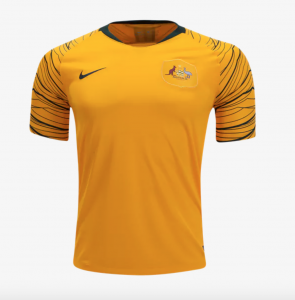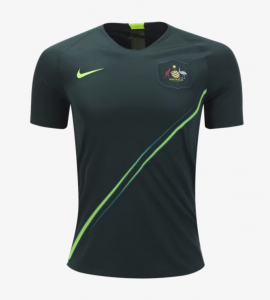Back to 2018 World Cup Underdogs
Team:
Australia
Team History:
In Australia, soccer is the most popular sport, both played and watched. This success is due in part to the two leagues governed by the FFA, the A-League and the W-League, which are nationally televised. Despite the popularity of the sport, the team has never advanced farther than the round of 16 which they reached in 2006. The road for the Australians isn’t easy though, even though the island nation is physically located in Oceania the team competes in the Asian qualifiers, a level up from the type of play they get in the OFC. In 2014, the Australians were placed in the group of death (Group B) with the Netherlands, Chile and Spain; it’s clear that the Australians are rarely given the easy way out. But despite their lack of history in the tournament the team is looking to build on their previous finishes and make it out of their group, which is significantly less competitive than that of which they were given in Brazil.
Key Players:
Star Player
Tim Cahill
Tim Cahill is a true leader, at age 38 he has played for clubs in four different countries and has 14 years of experience in the Australian national team. Cahill started his career in 1998 at Millwall in the Championship in England where he played for eight years; with 249 appearances and 56 goals it is no wonder English Premier League side Everton took notice. He went on to play for them for eight years, winning numerous awards and accolades including a nomination for the prestigious Ballon d’Or. In what were a good 12 years in England, Cahill decided to go to the United States where he signed with the New York Red Bulls. After a couple of years there he decided to play in the Chinese Super League for two different teams: Shanghai Shenhua and Hangzhou Greentown before heading home to Australia for a spell in Melbourne City. Finally, to finish his career, Cahill went back to his boyhood club on a season long deal of Millwall where he would play his last club season.
His international career began in Samoa since he resided there during part of his childhood, however, he was granted a change of allegiance with FIFA and decided to switch to Australia. Since the switch, Cahill has proved to be an indispensable player scoring 50 goals in over 100 appearances and was a pivotal force in the team’s run to the 2015 AFC Asian Cup championship.
Unknown Player
Mile Jedinak
Perhaps not as well known as Tim Cahill, Mile Jedinak is emerging to be even more of a star than the former. Jedinak began his career in the A-League playing for Sydney United for five years before he moved to the Central Coast Mariners for another three years. He eventually moved to Turkey to play for Gençlerbirliği before making the trek to England. In the Premier League he played for Crystal Palace until 2016 when he moved to Aston Villa where he now plays in the Championship.
For 10 years Jedinak has been a staple in the Australian national team with 75 caps and 18 goals. Now, he serves as captain of the team taking over the role of Tim Cahill; this leadership was evident in the intercontinental play-off when Jedinak scored a hat trick against Honduras to send his country through to the World Cup finals (see video below).
Path to Qualification:
The path to qualification for Australia was anything but easy as it took the team until the intercontinental play-off to qualify. After disappointing performances in the third round, Australia was forced into the Asian playoff with Syria where they won a tight game 3-2. From there Australia played an intercontinental playoff with Honduras; the first leg ended in a 0-0 draw and the pressure was on. Mile Jedinak single handedly sent Australia through to Russia scoring a hat-trick in the second leg.
Manager:
Bert van Marwijk
Unlike the case of the Korea Republic, Australia was faced with a different problem when manager Ange Postecoglou quit in November of 2017 during World Cup qualification. Postecoglou was under fire as his team severely underperformed in the early qualification stages up to the point where it left them with little hope to advance. Even after they qualified for the World Cup, the manager was still receiving a lot of heat and so he stepped down, thus opening the door for Bert van Marwijk to take over. As a player, Van Marwijk played for numerous clubs in the Netherlands in the Erevidisie never leaving his home country. However, as a manager is where he achieved most of his success. Most recently he was in charge of Saudi Arabia leading them to the World Cup in Russia, but perhaps his greatest achievement was in 2010 when he managed the Netherlands team to the World Cup final.
Country Reaction/Fandom:
With the men’s team qualifying for the World Cup yet again, and the recent success of the Australian women’s national team the fandom in Australia has grown considerably. The fans are a part of the Green and Gold Army, the supporters club founded in 2011 with more than 30,000 supporters in Australia and abroad, often traveling with the team to major tournaments or watching in local bars.
Packed stadium of Australian fans singing “Down Under” after qualifying for the World Cup
How Likely They Are to Advance:
Australia were drawn into Group C alongside France, Peru, and Denmark. With France being the obvious favorites to win the group, Peru, Denmark and Australia will be competing for the second spot. Both Peru and Denmark have a solid team of youngsters and put up a good showing during qualifiers. My prediction is that France and Denmark will advance, in that order.
Video of Best Moment of Qualifiers:
November, 15, 2017- Australia versus Honduras.This game can be described by two words: Mile. Jedinak. After scoring a great goal to start the game, Jedinak completed his hat-trick through two penalty kick goals. Honduras scored a late goal but it was just that, late, and Australia had qualified.
Kit:
Images taken from soccer.com
Fun Fact:
In 1967, journalist Tony Horstead coined the nickname “the Socceroos” for the Australian national team.
How to cite this article:
“2018 World Cup Underdogs: Australia,” Written by Alex Torres (2018). World Cup 2018 Guide, Soccer Politics Blog, Duke University, http://sites.duke.edu/wcwp/tournament-guides/mens-world-cup-2018-guide/2018-world-cup-underdogs/australia/ (accessed on (date)).
Written by Alex Torres
Sources:
“Bert Van Marwijk.” Wikipedia, Wikimedia Foundation, 30 Apr. 2018, en.wikipedia.org/wiki/Bert_van_Marwijk.
“Football Federation Australia.” Home, www.ffa.com.au/.
“Mile Jedinak.” Wikipedia, Wikimedia Foundation, 30 Apr. 2018, en.wikipedia.org/wiki/Mile_Jedinak.
“Socceroos.” Home, www.socceroos.com.au/.
“Tim Cahill.” Wikipedia, Wikimedia Foundation, 30 Apr. 2018, en.wikipedia.org/wiki/Tim_Cahill.
Back to 2018 World Cup Underdogs


